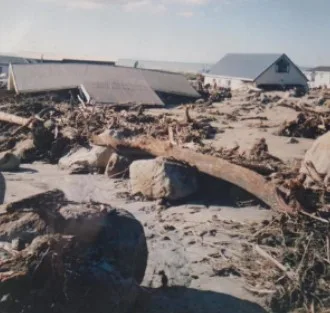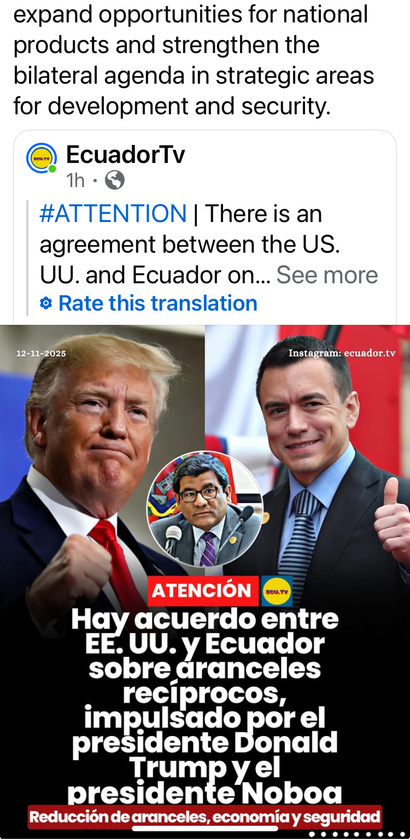01NOV23- El Niño: The state of alert in Ecuador has been changed in response to the El Niño phenomenon- “Unanimously, the National COE learned of the report from the Oceanographic and Antarctic Institute of the Ecuadorian Navy for the issuance of an orange alert for the El Niño phenomenon. This is established under compliance with technical parameters,” said the Minister of the Interior, Juan Zapata. This decision was reached during a meeting held at the ECU-911 facilities in Quito and was presided over by Vice President Alfredo Borrero.
“The institutions will follow the action plan to articulate mitigation efforts against the El Niño phenomenon,” added the head of that State portfolio
The early impact of the El Niño weather system is being felt in Ecuador’s coastal region and will intensify in the coming weeks, according to the latest report by the Ecuadorian Navy’s oceanographic institute.
“In readings taken last October 31, the sea level is 15 centimeters above normal, and the water temperature has reached 23.7 degrees, which is three degrees above normal,” the Navy’s Regional Study of the El Niño Phenomenon reports. “This data indicates the arrival of a strong El Niño, as predicted.”
According to Rommel Suntaxi of Ecuador’s Meteorological Institute, unseasonably intense storms have been recorded in El Oro, Guayas, Manabi and Esmeraldas Provinces since October 16. “Rainfall on the coast and littoral will gradually intensify in the coming weeks,” he said, adding that the full impact of El Niño may not be felt until December and January.
“The intensity of the weather system is difficult to predict since there are many variables, but we know this will be one of the strongest El Niños since the 1997 and 1998 event, which caused a great deal of destruction,” Suntaxi said.
According to Michael Linthon, director of the Naval institute, it is important for the population to understand the threat it faces from El Niño. “There is some confusion about this since most attention is focused on the potential damage of floods in the coastal region,” he says. “We are all familiar with the horrible impacts of the 1998 El Niño.
Flooding rains will occur at lower elevations near the coast and in the western foothills of the Andes Mountains, Linthon explains. “The heaviest rain will fall on the coast and at elevations up to 1,000 meters (3,300 feet) with elevations between 1,000 and 1,500 meters experiencing higher than normal amounts,” he says.
At higher elevations, and in the inter-mountain valley, there will be below average rainfall and drought conditions. “We are already experiencing the impact of this with electricity rationing and the drought could extend to February and March of next year,” he says.
El Niño’s impact in the Amazon region, on the east side of the Andes, is more difficult to predict, says Linthon. “We expect drier than normal conditions, but this depends on several factors that will develop in the coming weeks. The entire Amazon basis, all the way to the Atlantic Ocean, is seeing drought conditions unrelated to El Niño and this could be exaggerated by its effects.”
Linthon says the impact of El Niño will be similar in neighboring Peru and Colombia. “This is a regional phenomenon and is why Colombia is unable to provide us with hydro-generated electricity. The drought has also reduced the level of their rivers and reservoirs.”
Linthon cautions against assuming we are facing a repeat of 1997 and 1998. “Obviously, we must be prepared for the worst but, on the other hand, it is far too early to make any precise predictions.”
El Niño’s Impact on Ecuador:
El Niño is a climate pattern that occurs irregularly, but on average every 2 to 7 years, in which the Pacific Ocean’s surface temperatures become warmer than normal. This warming can affect weather patterns and ocean currents around the world. In Ecuador, El Niño can have a significant impact on weather patterns and ecosystems.
One of the most noticeable effects of El Niño in Ecuador is increased rainfall. During El Niño years, the country can experience heavy rains and flooding, particularly in coastal regions. This can cause damage to infrastructure and crops, as well as lead to displacement of communities.
In addition to heavy rainfall, El Niño can also lead to warmer temperatures in coastal regions of Ecuador. This can have implications for both ecosystems and tourism. Warmer waters can disrupt the marine food chain and lead to reduced fish populations, which can impact fishing industries. On the other hand, warmer temperatures can make beach destinations more appealing to tourists.
Another potential impact of El Niño in Ecuador is increased risk of landslides and erosion. Heavy rainfall can destabilize soils and lead to dangerous landslides in mountainous areas. This can cause significant damage to homes and infrastructure, as well as pose a threat to human safety.
Despite the potential negative effects of El Niño, there are also some benefits. Increased rainfall can lead to improved soil moisture and crop yields, which can be beneficial for agriculture. Additionally, warmer waters can attract certain fish species that are more desirable for fishing.
Overall, the impact of El Niño on Ecuador can be significant, both in terms of negative and positive effects. The government and communities take measures to prepare for and respond to the impact of El Niño, including early warning systems, infrastructure improvements, and emergency response plans."
Sources:
🤠iffin you gonna move down or remain in Ecuador on into 2025, get prepared for whats a coming down the pike🥷🏼its not and has not been just a Coastal & #GYE thang, its also a Sierra & Metro #Quito Thanggy as well👮🏻♂️💰
My 2025 NewYears Resolution is more time out on the La G range, zz style, 🎸🥁🎸 cuzz (imho) we gonna dang sure be a needin it🥷🏼if anybody wants to no longer be an outlaw? Call me to join our Qtowne Quito gun club and get legal to tote with a 55hr CCW Course,
now a days The CCW is pretty much streamlined down to this:
plan on about $300 for to join the gun club,about $200 or up to $300 for the CCW course,about $300 for psyche, psycho and toxico exams,
a 9mm Taurus for say $1200.
a 9mm CZ for say $1500.
aprox $80 to $100 for a box of 50rds 9mm FMJ
i see peeps now a days getting legally armed in about a 3-4 months time frame, kinda like a tuff assed visa process!
'Always be prepared' - BSA & SA,
"When guns are outlawed, only outlaws will have guns" - Louis L'Amour (1908-1988) Western novelist of ...
(there will be no significant improvement in Ecu until this addressed and resolved once and for all, very similar issues up NA way too, Ecu mini state likes to monkey see monkey doo big brother brothel USSA in so many ways:) 03DEC25- #Ecuador ⚖ 'Life imprisonment! For corrupt judges & lawyers- "...So, let's use the same logic with my "buddies." If as a lawyer you are found guilty of having bribed a judge or prosecutor or you are that judge or prosecutor bribed, it is impossible for us to think that it is coherent that we can once again entrust them with their participation in the system of administration of justice.
A corrupt judge, lawyer or prosecutor must be banned for life from practicing the profession. Let them go out to sweep streets or pass cafes, but in this profession they cannot participate again. Because without Justice there is no State and they have made sure that Ecuador is a failed State.
But I am more radical: I propose that the perpetual inability to practice the profession ...
SUN 23NOV25 The #EcuadorReport Giving Thanks to the Entire Crew at KAT-BAS Club de Tiro #Quito Gun Club - 'Nobody is Coming to Save You!'🦃Have a Happy Thanksgiving 2025🎩-
13NOV25 📑#Ecuador
"There is an agreement between the US and Ecuador on reciprocal tariffs, driven by President Donald Trump and President Noboa.
The United States announced the elimination of reciprocal tariffs for certain Ecuadorian exports, following the conclusion of a new agreement promoted by President Donald Trump and President Daniel Noboa.
The understanding incorporates chapters of trade, work, environment and security, with the aim of providing greater competitiveness and relief to the export sector of Ecuador.
The Minister of Production and Foreign Trade, Luis Jaramillo, stressed that this framework "will lay the foundations of trade, economic and national security relations", emphasizing that the agreement marks a decisive step to deepen cooperation between the two countries.
According to the Ecuadorian Government, the measure will allow to expand opportunities for domestic products and strengthen the bilateral agenda in strategic areas for development and security." -
...



















